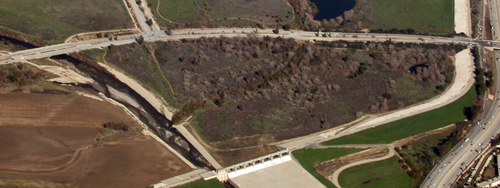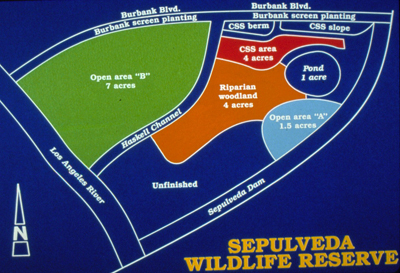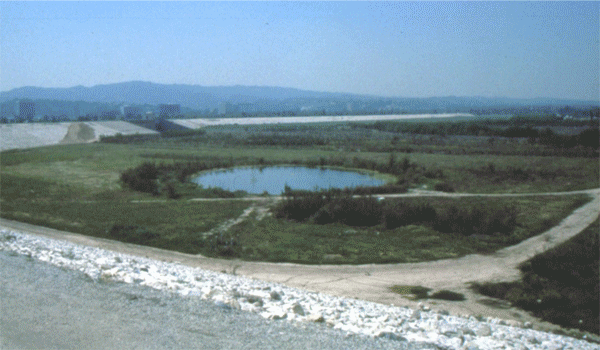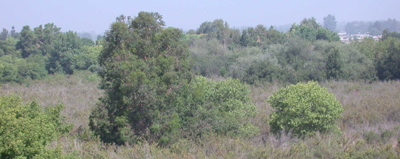 |
|||||||||||||||||
|
|||||||||||||||||
South Reserve |
|||||||||||||||||
HISTORY |
|||||||||||||||||
The South Reserve was the first area of the Sepulveda Basin to be revegetated with California native plants. Previously the site had been used for agricultural purposes. The 1981 Sepulveda Basin Master Plan and Final Environmental Impact Report/Statement set aside 48 acres of land in the southeast corner of the Basin contained by Burbank Blvd., the L.A. River channel and the Sepulveda Dam for a “Wildlife Refuge (or Management Area).” The plan called for “preparation and management of three habitat areas – a sage/grass area, a riparian/willow area, and a freshwater lake. The coastal sage and meadow habitat, occupying the northwestern part of the area, is envisioned as requiring relatively little preparation since natural succession should create the desired habitat, would be developed with walking paths for wildlife observation, and would not be fenced off. The existing drainage channel bisecting the site would be widened to create a riparian/willow habitat, in which natural succession will be supplemented by planting willows on the western edge to separate the area from the sage/grass habitat.” |
||
The Corps of Engineer’s original development plan for the south Reserve consisted of four management areas: a grassland habitat, mainly composed of the perennial bunchgrass purple needlegrass (Nasella (Stipa) pulchra); riparian woodland associated with streamsides and floodplain; coastal sage scrub; and aquatic habitat. These areas were planted from 1979-1984. Some areas were left open (not planted with trees and shrubs) and designated as raptor foraging areas. |
||
| After the plants were installed there was a lack of management and control of weeds in the south reserve. Horehound and giant reed began to take hold soon after the floods of 1993. Eucalyptus, tree of heaven, evergreen ash and some non-native pine trees volunteered and began to invade. |
||
Starting in 1993, the Tillman Flood Control Project required re-routing of the outflow from the sewage treatment plant which meant excavation for the placement of a pipeline through the south Reserve. After the project was completed, the portion that was denuded by the excavation was replanted with appropriate native plants. |
||
The Wildlife Area expansion plan (implemented in 1999) resulted in an improved trail along the south side of Haskell Creek, with a bridge crossing leading to the intersection of Woodley Avenue and Burbank Blvd. A non-improved trail leads to the Los Angeles River, where there is a great view of where Haskell Creek empties into the River. |
||
FLORA |
||
Surrounding the pothole pond are willows (Salix spp.), both Fremont and black cottonwood (Populus fremontii and P. trichocarpa), box elder (Acer negundo) and coast and valley oaks (Quercus agrifolia and Q. lobata). Non-native irises and palm trees are a problem. Haskell Creek has willows, cottonwoods, box elder and numerous non-native trees and shrubs. The shrublands are dominated by mulefat and coyote bush (Baccharis salicifolia and B. pilularis). The annual vegetation is mostly non-native grasses, thistles, and horehound. Certain perennial non-native grasses are also invading some areas. Since this portion of the Basin floods with more regularity than any other area, regular surveys to look for new infestations will always be required. |
||
FAUNA |
||
The pothole pond attracts ducks and wading birds, but it is a small pond surrounded by tall trees. The pond has mosquito and other fish, non-native bullfrogs, and tree frogs. The riparian scrub is good habitat for the rare bird – the Least Bell's Vireo – that has been seen in the area. |
||
ISSUES |
||
As the native vegetation matured, a few problems were revealed. Evergreen ash (Fraxinus uhdei) invaded Haskell Creek where there are now many large ash trees that are towering above the native shrubs and trees. Eucalyptus trees have gotten too large to cut down without agency assistance. Since the area is relatively remote, homeless persons regularly set up camps, and that has led to wildfires. Because of the threat of loss of life and because of the areas relative inaccessibility, the L.A. City Fire Dept. has requested that fireroad be bulldozed from the tunnel south to the dam face; this project has yet to be approved. The Corps of Engineers regularly disks (plows) the area just north of the dam; this regular disturbance of the soil results in lots of weeds, and it is here where infestations of perennial pepperweed (Lepidium latifolium) and yellow star thistle (Centaurea solstitialis) have been found; steps to control these invasive weeds have been taken. |
||
|
A TRIP DOWN MEMORY LANE |
||
|
Starting in 1979, Silvia Nefas, Rick Harlacher and I were hired by the Corps of Engineers to plan and plant the Sepulveda Basin Wildlife Preserve revegetation project that's become the South Reserve. (Rick, Silvia and I were hired from Cal Poly Pomona where we were full-time students and worked only part-time for the Corps. None of us were professionals - yet.) We collected all the seed for the various native plants and grew them out first at a nursery we established at the Whittier Narrows Nature Center and later moving to the Corps of Engineers Construction and Operations Facility adjacent to Legg Lake in South El Monte. An immense amount of work and planning went into that first little Wildlife Preserve. Rick was our biologist, Sylvia, our horticulturalist, and myself, the botanist. We performed numerous surveys of the extant plant assemblages. As a matter of fact, like good little government workers, we generated copious amounts of paper while documenting everything we planned to do and eventually we did for and in our corner of the basin, including pre- and post-planting follow-up studies. We also did the initial planning for the lake area north of Burbank. From reading your website, it seems that many of our records have been lost. We selected plant species based on the physical environment behind the dam, the species native to the area and the needs of the fauna, especially birds. Riparian on the bottom-land and coastal sage/chaparral species on the hotter, drier south-facing berms. It was sad to read about the non-native ash trees taking over Haskell Creek. (Whoa! I just realized that we began our project almost 30 years ago!) It was nothing but a wonderful tangle of willows "back in the day". There was also a big subterranean nest of the most vicious yellow jackets on the west side of Haskell. Some things, like being attacked by angry yellow jackets and having to run for our lives, are never forgotten;) These words from your website regarding the Coastal Sage Community brought tears to my eyes: "...plants common to this plant community have been planted mostly in the South Reserve along the south-facing berm of Burbank Blvd". I wanted to compare the success of CS plants seeded in place with pot-grown plants. While we had hundreds of members of the Los Angeles community - mostly school children and scout groups - help plant the South Reserve, including some pot-grown CS plants on the berm, only Sylvia and I seeded the berm. It was hot on that south-facing slope that Fall of, I think, 1983. The placement of every seed was planned, hand-made exclusion barriers put in place to protect the emerging seedlings from the voracious rabbits and each site tagged with date, species and number of seeds planted. We planted across the entire berm from the tunnel under Burbank east to the northeast corner. It was a beautiful sight. Of course, an El Nino struck that winter and the basin flooded....It really flooded. The berm looked like a bomb had hit it. Few of our seeding placements were visible and a number of the potted plants that had been planted previously had been washed away. Everything was coated with fine silt. The most remarkable thing about the flooding occured the following Spring. There had been a Fall fire upstream of the LA River, by the Simi Hills, and the burned hillsides had been seeded with Rye grass. The Spring following the flooding the entire basin south of Burbank was lush with Rye grass. I started a Masters program in Botany at UCR in the Spring of 1984 and quit my work with the Corps the following Fall. Because of my schedule I spent my last months at our nursery never returning to Sepulveda. I've wondered off and on through the years if any of the coastal sage plants on the berm survived that flooding. It's very satisfying to know that they did. (Note: Rick was promoted to Corps ecologist in 1982 or '83 and left the project. Silvia resigned in 1985.) The '"pothole pond" was part of the plan. It's sitting exactly where we wanted it to be. We staked out the area and supervised the removal of the dirt. (Now, I wish we'd taken more pictures.) After the earthmovers were done the area was barren, completely devoid of vegetation. Once they were in the ground, the cottonwoods and willows took off and soon the area began to look like it might support life. I remember the day I walked up to the edge of the pond planning to check on some aquatics we'd planted out, turned to my right and was face-to-beak with a great blue heron. Having only seen them in flight or from some distance away, I was awed by its height - and I'm 6 feet tall. When the planning began for the lake, etc. north of Burbank I advocated keeping part of the land there in corn production because very large flocks of Canada geese used the harvested cornfields as a food source. I hope there's still something for them there. We planted in the Fall of 1981, 1982, 1983 and 1984. We laid 1700 feet of 4 inch water pipe from the main at Burbank and the LA River/Woodley east to the old agricultural valves north of the pond. We put in a water system with ag rainbirds to summer water the first plantings of trees and shrubs in a large area around the pond. When the initial plants grew too big to use rainbirds in the area, we trailored in a water tank and hand-watered subsequent years' plantings. We initially established a drip water system for the plantings on the berm but rodents loved gnawing holes in the black polypropeline pipe and lines. After making repairs, we'd flush the pipe before reattaching the drip heads and gopher snakes would come swooshing out the end. There were large numbers of rabbits and gopher snakes in the area. Bird-wise, Anna's hummers and mourning doves were abundant. The doves nested on the ground and would perform a "broken wing display" if we walked too close to a nest. Comparing the well-constructed, tidy nests the Doves built on the ground with the horribly ill-constructed nests they make in trees, I concluded that doves are ground-nesting birds. Yellow chats would perch in the tree tobacco and scold us. There were also meadow larks. Each spring a large flock of swallows made nests in the tunnel under Burbank. After the pond was established, the common aquatic birds moved in. I saw my first kingfisher there. Rick did the fauna assays. I was only an amateur observer. There wasn't much species diversity which we attributed to the poor habitat and consistent alteration of the area by man and periodic flooding. The Sepulveda revegetation project was a lot of very hard, physical work and it's satisfying to know that the plants we first held in our hands as seeds are there forming an island of established habitat. It's also more than satisfying to know that construction of habitat on Corps land has become acceptable. The South Reserve was an experiment for the Corps. We met with nothing but resistance from the "Old Guard" at the Federal Building downtown and bristled every time we were asked how our "weeds" were growing. For many of our colleagues in the Corps our project was a touchy-feely joke. We had a devil of a time getting the guys charged with weed control not to spray or disc and kill the plants we'd put out. (They wiped out a whole oak grove we'd planted using expensive boxed trees as part of a mitigation project at Prado Dam.) submitted by email on Nov. 18, 2008 |
||





